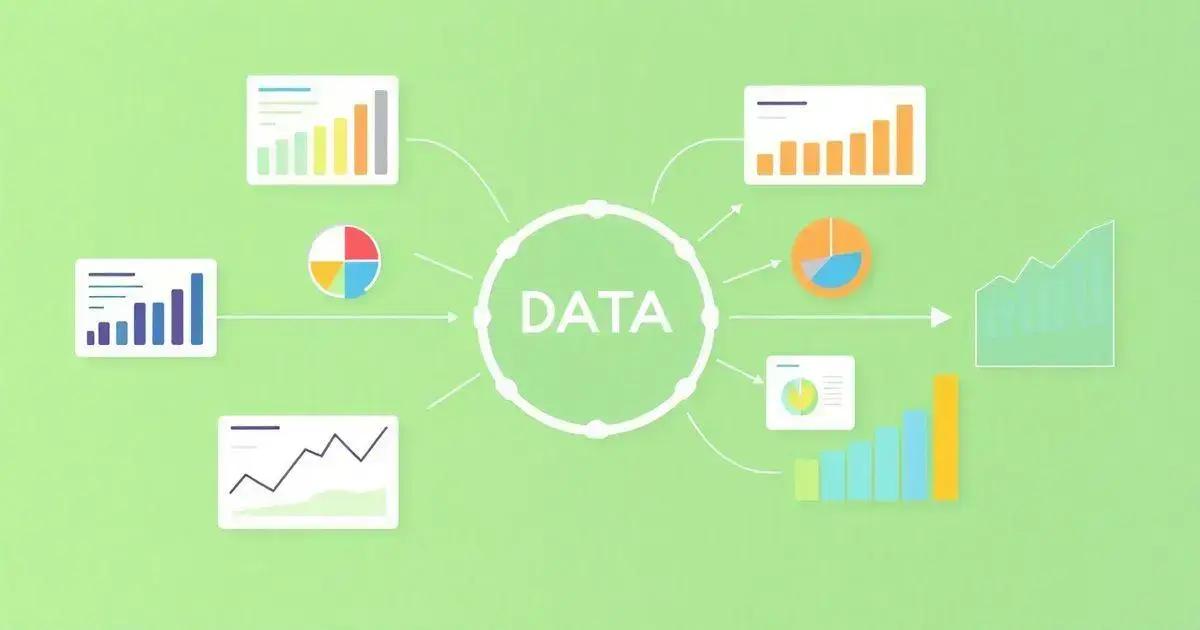The power of data analysis in decision-making is revolutionizing the way organizations operate. By leveraging insightful and data-driven strategies, businesses can make informed choices that drive growth and efficiency.
From identifying trends to predicting outcomes, data analysis offers invaluable tools for crafting effective strategies. It not only enhances accuracy but also uncovers opportunities that might otherwise go unnoticed.
Curious to see how data analysis can reshape your approach? Explore its transformative role in decision-making and discover how it can propel your organization towards success.
Understanding Data Analysis
Understanding data analysis is crucial for making informed business decisions. It involves examining data sets to draw conclusions about the information they contain. Data analysis can help organisations identify trends, patterns, and anomalies that can influence strategic decisions.
What is Data Analysis?
Data analysis refers to the process of systematically applying statistical and logical techniques to evaluate data. The main goal is to transform raw data into meaningful information. This can involve various methods such as summarising data, finding correlations, or forecasting trends.
The Importance of Data Analysis
By utilising data analysis, companies gain insights into their operations, customer behaviours, and market conditions. This knowledge equips decision-makers with concrete evidence, reducing reliance on guesswork. With accurate data analysis, businesses can make timely decisions that align with their goals.
The Role of Data in Decision-Making

The role of data in decision-making is vital for any successful organisation today. Data serves as the backbone for informed choices across different business sectors. It helps leaders to understand market trends, customer preferences, and operational efficiencies.
Data as a Decision-Making Tool
Data provides valuable insights that enable managers to make choices based on evidence rather than intuition. This shift leads to improved outcomes, as decisions are backed by facts and comprehensive analysis.
Turning Data into Action
Once data is collected and analysed, organisations must act on those insights. This can mean adjusting marketing strategies, changing product offerings, or reallocating resources. The quicker a business can adapt, the more competitive it will be.
Real-Time Data for Swift Decisions
Access to real-time data allows leaders to respond swiftly to changes in the market. This agility can result in significant advantages over competitors who may not adapt as quickly. Real-time insights ensure that organisations can seize opportunities and mitigate risks immediately.
The Importance of Data-Driven Culture
Fostering a data-driven culture is essential. Employees at all levels should understand the value of data and how to use it in their day-to-day activities. This not only improves decision-making but also encourages innovation within the team.
Building Trust in Data
For data to effectively guide decision-making, trust is crucial. Organisations must ensure that data is accurate, reliable, and relevant. This may require implementing data governance frameworks to maintain data quality.
Case Studies of Data-Driven Decisions
Looking at case studies where data played a key role can provide insights into its effectiveness. Examples of companies successfully utilising data for strategic decision-making can illustrate best practices and encourage others to embrace data-driven approaches.
As organisations continue to harness the power of data, its role in decision-making will only grow more prominent. Understanding and leveraging data effectively can lead to significant competitive advantages.
Key Tools for Data Analysis
Key tools for data analysis play a significant role in helping organisations interpret and leverage their data effectively. Using the right tools can streamline the data analysis process and enhance decision-making capabilities.
1. Spreadsheets
Spreadsheets like Microsoft Excel and Google Sheets are foundational tools for data analysis. They allow users to organise, manipulate, and analyse data effectively. With built-in functions and formulas, users can perform calculations and create charts to visualise data trends.
2. Data Visualisation Tools
Data visualisation tools such as Tableau and Power BI enable organisations to transform complex data sets into interactive visualisations. These tools help decision-makers to interpret data quickly and effectively. Visualising data provides insights at a glance, facilitating better understanding and collaboration.
3. Statistical Analysis Software
Tools like R and Python, with their statistical libraries, allow for advanced data analysis. These programming languages empower analysts to perform sophisticated data operations, ranging from regression analysis to machine learning algorithms. They offer flexibility and power when handling large datasets.
4. Business Intelligence (BI) Tools
Business Intelligence tools like SAS and QlikSense allow organisations to integrate data from different sources and generate meaningful reports. These tools enable users to track key performance indicators (KPIs) and monitor real-time data, supporting informed decision-making.
5. Customer Relationship Management (CRM) Systems
CRMs such as Salesforce and HubSpot collect and analyse customer data. They provide insights into customer behaviour, preferences, and trends, helping businesses tailor their marketing strategies and enhance customer experiences.
6. Data Mining Tools
Data mining tools like RapidMiner and KNIME allow users to extract hidden patterns from large datasets. These tools help organisations to uncover valuable insights that can lead to better predictions and informed decisions.
7. Cloud-Based Data Analytics Tools
Cloud platforms such as Google Cloud and AWS provide powerful data analytics services. These tools offer scalable solutions to store and process large volumes of data, making it easier for businesses to access and analyse information anytime, anywhere.
Integrating these tools into the data analysis process enhances the ability to interpret data effectively, leading to smarter business strategies.
Synthesizing Data for Strategic Insights

Synthesizing data for strategic insights is crucial in making informed business decisions. This process involves combining data from various sources to create a clear picture of trends and patterns that can guide strategy.
The Importance of Data Synthesis
Synthesis helps in transforming raw data into valuable information. By merging datasets, businesses can uncover relationships and gain insights that single datasets might not reveal. This comprehensive view is essential for effective decision-making.
Methods for Data Synthesis
There are several methods to synthesise data:
- Aggregation: This involves summarising data points into a single value, such as calculating the average sales over a month.
- Integration: Combining data from different sources to create a unified dataset. This is often done with the help of data integration tools.
- Comparison: Analysing different datasets side by side, which can help identify trends or discrepancies.
Utilising Visualisation Tools
Visualisation tools play a crucial role in synthesising data. Tools such as Tableau and Power BI allow organisations to create visual representations of their data. This makes it easier to see patterns, trends, and anomalies, helping stakeholders make informed decisions quickly.
Collaboration Across Teams
Synthesising data is often a team effort. Collaboration between different departments, such as marketing, finance, and operations, can lead to a more comprehensive understanding of the data. By sharing insights and perspectives, teams can formulate strategies that reflect a holistic view of organisational needs.
Real-World Applications
In real-world scenarios, businesses can apply data synthesis to improve their strategies. For instance, a retail company might combine sales data with customer feedback to optimise inventory and enhance customer satisfaction. This approach can lead to increased sales and loyalty.
Continuous Improvement
Synthesising data should not be a one-time event. Businesses must regularly review and update their data synthesis processes. By continually refining these methods, organisations can ensure they are always making well-informed decisions based on the most current and relevant data.
Common Pitfalls in Data Interpretation
Common pitfalls in data interpretation can lead to incorrect conclusions and poor decision-making. Identifying these issues is crucial for effective data analysis.
1. Overgeneralization
Making broad conclusions from a small data set is a common mistake. Data interpretation should always involve a representative sample. Relying on too few data points can result in misleading insights.
2. Confirmation Bias
Confirmation bias occurs when analysts only look for data that supports their existing beliefs. This can lead to overlooking significant information that contradicts their hypotheses. To combat this, it is essential to approach data analysis with an open mind.
3. Ignoring Context
Data must be interpreted in context. Failing to consider external factors, such as market trends or economic conditions, can distort the understanding of data. Analysts should always look at the bigger picture.
4. Misreading Correlation as Causation
Just because two variables are correlated does not mean one causes the other. Misinterpreting correlation as causation can lead to flawed strategies. Analysts need to conduct further research before making causal claims.
5. Lack of Proper Tools
Using inadequate tools for data interpretation can undermine the quality of analysis. It’s essential to use appropriate software and methodologies that align with the data type. This ensures accurate interpretations and insights.
6. Failure to Validate Results
Data findings should be validated before implementation. Skipping this step can result in basing decisions on inaccurate information. Techniques like peer review or additional testing can help confirm results.
7. Poor Communication of Findings
The way data findings are communicated can impact decision-making. Presenting data without clarity or context can lead to misunderstandings. Organisations should strive for clear, concise communication of insights to improve comprehension.
8. Not Updating Interpretations
As new data becomes available, earlier interpretations may need revisiting. Businesses often fail to adjust strategies based on the latest data trends. Regular updates to data interpretations can keep businesses agile and informed.
The Future of Data Analysis

The future of data analysis is rapidly evolving, driven by technological advances and increasing data volumes. As organisations continue to adopt data-centric approaches, several trends are likely to shape the landscape of data analysis.
1. Increased Use of Artificial Intelligence and Machine Learning
AI and machine learning will play a significant role in transforming data analysis. These technologies can automate complex processes and uncover patterns that traditional methods may miss. As they become more integrated into data analysis tools, AI will enhance decision-making capabilities.
2. Real-Time Data Processing
The demand for real-time data analysis is on the rise. Businesses will increasingly rely on instant insights to make timely decisions. Technologies capable of processing and analysing data in real time will be critical for organisations looking to stay ahead in competitive markets.
3. Greater Emphasis on Data Privacy and Security
With more data being collected, concerns about privacy and security will intensify. Future data analysis practices must prioritise ethical data use, compliance with regulations, and robust security measures to protect sensitive information.
4. Data Democratization
Data democratization is the process of making data accessible to non-technical users. This trend will enable more employees to leverage data for decision-making. As self-service tools become more user-friendly, businesses will foster a culture of data-driven insights across all levels.
5. Enhanced Data Visualisation Techniques
As data complexity increases, effective visualisation tools and techniques will be essential. Future tools will provide enhanced ways to present data, making it easier for stakeholders to understand insights quickly and clearly.
6. Integration of IoT Data
The Internet of Things (IoT) will generate vast amounts of data. Integrating IoT data into analysis will offer deeper insights into consumer behaviour and operational efficiency. Businesses that can harness this data will gain a competitive edge.
7. Focus on Predictive and Prescriptive Analytics
The shift from descriptive analytics to predictive and prescriptive analytics will continue. Businesses will use these advanced methods to not only forecast future trends but also recommend actions based on data-driven predictions, enhancing strategic planning.
8. Continuous Learning and Adaptive Analysis
The future of data analysis will require continuous learning. Analysts must adapt to evolving tools and methodologies. Embracing ongoing education and training will be crucial to staying relevant in the dynamic field of data analysis.
Case Studies in Effective Data Use
Case studies in effective data use demonstrate how organisations can leverage data to drive success. Here are several examples of businesses that have excelled through strategic data analysis.
1. Retail Chain Enhancing Customer Experience
A popular retail chain used data analysis to understand customer buying patterns. By examining purchase history and feedback, they customised marketing campaigns tailored to specific customer segments. As a result, they experienced a 20% increase in customer retention and sales.
2. Financial Institution Reducing Fraud
A financial institution implemented predictive analytics to enhance their fraud detection. By analysing transaction data and identifying unusual patterns, they reduced fraudulent transactions by 30%. Implementing machine learning algorithms allowed them to adapt quickly to new fraud strategies.
3. Healthcare Provider Improving Patient Outcomes
A healthcare provider utilised data analytics to track patient follow-ups and treatment responses. By analysing this data, they identified areas for improvement in patient care. This led to a 15% decrease in readmission rates, significantly improving overall patient outcomes.
4. Manufacturing Firm Optimising Production
A manufacturing company leveraged IoT data to monitor machine performance in real-time. By analysing this data, they implemented predictive maintenance schedules. This proactive approach reduced downtime by 25% and saved millions in operational costs.
5. E-commerce Platform Personalising Recommendations
An e-commerce platform used data analytics to personalise product recommendations for customers. By analysing browsing and purchasing behaviour, they were able to increase their conversion rates by 30%. This tailored approach enhanced customer satisfaction and loyalty.
6. Travel Company Streamlining Operations
A travel agency integrated data analysis to streamline operations and improve customer experiences. By examining booking patterns and customer feedback, they optimised their offerings and increased satisfaction rates by 40%.
7. Telecommunications Company Enhancing Network Performance
A telecommunications company used data analytics to identify areas with poor network performance. By targeting these areas for upgrades based on data insights, they improved customer satisfaction scores by 35% and reduced churn rates.
8. Online Learning Platform Increasing Engagement
An online learning provider analysed user engagement data to enhance course offerings. By identifying trends in course completions and user feedback, they redesigned their content, resulting in a 50% increase in user engagement.
Building a Data-Driven Culture

Building a data-driven culture is essential for harnessing the full potential of data analysis in any organisation. This culture encourages employees at all levels to make decisions based on data rather than intuition.
1. Leadership Commitment
Creating a data-driven culture starts at the top. Leadership must demonstrate a commitment to data-driven decision-making. This sets the tone for the entire organisation, showing employees the importance of using data in their roles.
2. Training and Education
Investing in training and education is vital to building data literacy among employees. Providing workshops, online courses, and resources helps staff understand how to analyse and interpret data effectively.
3. Accessible Data
Ensuring that data is accessible to all employees is crucial. Implementing user-friendly tools and dashboards allows team members to easily access and analyse information relevant to their work. This accessibility empowers them to make informed decisions.
4. Encouraging Collaboration
Fostering a collaborative environment is essential for a data-driven culture. Teams should share insights and data findings freely. Collaboration across departments enhances the overall understanding of data and its implications on business strategies.
5. Celebrating Data Successes
Recognising and celebrating successes that come from data-driven decisions boosts morale and encourages further use of data analysis. Sharing success stories inspires others to utilise data in their work.
6. Iterative Processes
Building a data-driven culture involves continuous improvement. Encourage teams to iterate on their data processes, learning from past projects to refine their techniques. This mindset cultivates innovation and adaptability.
7. Integrating Data into Daily Workflows
To build a data-driven culture, organisations need to integrate data analysis into everyday workflows. This means making data a part of regular meetings, reports, and decision-making processes. When data is consistently used, it becomes second nature.
8. Setting Clear Goals
Establishing clear goals related to data use helps employees understand expectations. By setting measurable objectives around data projects, organisations can track progress and motivate teams to achieve data-driven outcomes.
Embracing the Power of Data Analysis
The analysis of data presents incredible opportunities for organisations aiming to enhance their decision-making processes. A data-driven approach empowers businesses to harness insights that can lead to improved efficiencies and competitive advantages.
Through the effective use of data analysis, organisations can learn from case studies, avoid common pitfalls, and foster a culture that embraces data at all levels. By committing to training, collaboration, and the use of modern tools, businesses can build a robust framework that supports the intelligent use of data.
As we look to the future, the role of data in shaping successful strategies will only increase. Embracing a holistic approach to data analysis will undoubtedly lead to more informed decisions and better business outcomes.
Ultimately, the journey towards being data-driven is invaluable; it can transform the way organisations operate and compete in today’s dynamic market.
